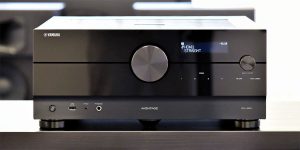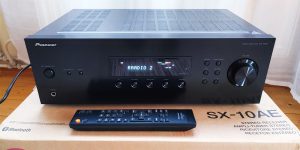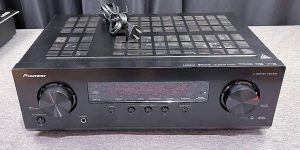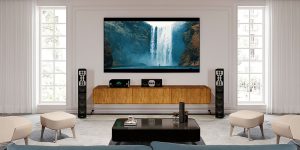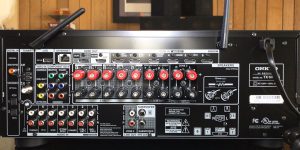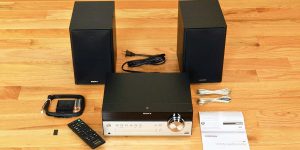AV receivers with 7 channels of amplification are the most popular today, as they can offer more functionality compared to 5-channel receivers, but at the same time continue to occupy the budget segment. This is particularly true in surround sound, as such a coveted surround sound format as Dolby Atmos is unavailable with 5 channels. In this best 7 channel receivers review, I have gathered models from different brands differing in price and functionality, reviewed their advantages and disadvantages, and described some key factors that, in my opinion, should determine your final choice. With any of the proposed AVRs, you can build a home theater system, which, with a minimal configuration, can give you the unique effect of the upper channels while saving you money.
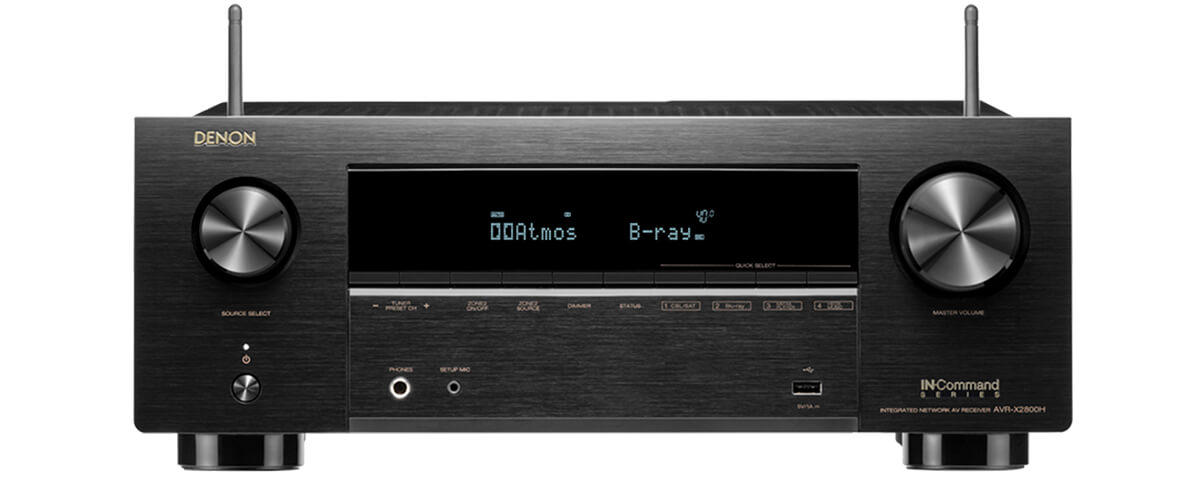
7-channels receivers comparison table
| Name | Channels | Power output | HDMI in/out | Bluetooth/Wi-Fi | Review |
|---|---|---|---|---|---|
| Denon AVR-X2800H best overall | 7.2 | 100W/8 Ohm, 210W/6 Ohm | 6/2 | yes/yes | Review |
| Marantz Cinema 70S also great | 7.2 | 50W/8 Ohm, 70W/6 Ohm | 6/3 | yes/yes | Review |
| Onkyo TX-NR6100 budget | 7.2 | 100 W/8 ohms | 6/2 | yes/yes | Review |
What 7-channels receivers did we test?
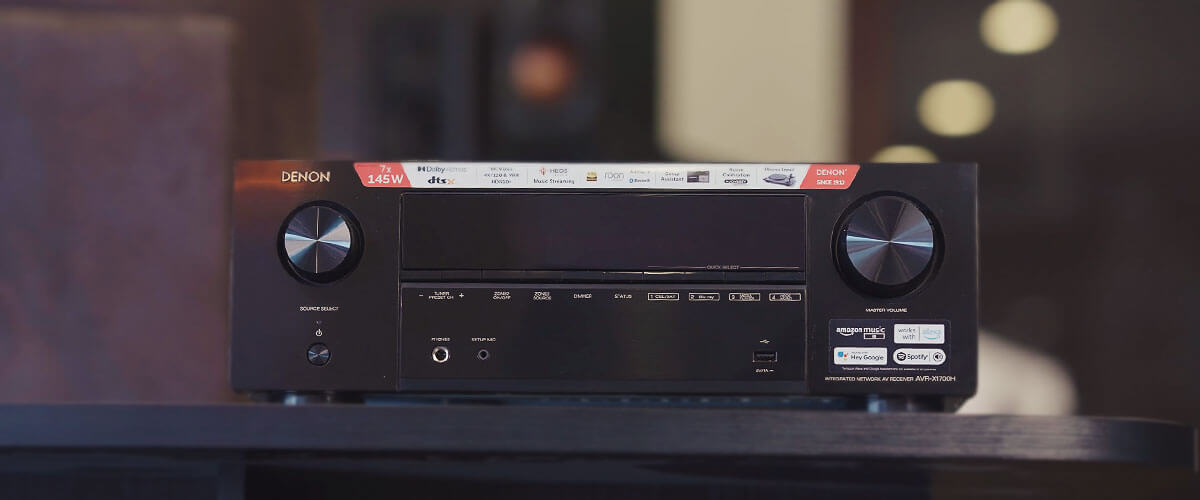
Before we start the review, it’s worth mentioning some points. For example, to compile the list of top 7.2 AV receivers in 2025, I studied a larger range of devices, and as a result, the rating did not include such models:
Denon AVR-X1700H was not included in our top because the review has a newer, better model with more functionality – Denon AVR-X2800H. For the same reason, the Marantz 1711 receiver was not included because the brand has – the Marantz Cinema 70S.
Onkyo TX-SR494 did not become the best 7.2 receiver for a combination of technical reasons along with personal preferences.
In addition to my personal impressions from testing, I also considered customer reviews from various retail sites and the opinions of other users and experts from popular audio forums. This approach helps me to keep objectivity when assigning “winning” places for the models under consideration.
Our criteria for choosing the best 7.2 receiver
As usual, the criteria for forming the selection were the following factors: required number of amplification channels, listening experience, availability of necessary built-in functions (Bluetooth, Ethernet/Wi-Fi, AM/FM tuner), sufficient number of inputs and outputs of connections, price, quality of performance and design of the receiver.
Best 7.2 AV receivers reviews
Denon AVR-X2800H – best overall

Not too long ago (relative to 2025, as I am writing this review), Denon released the Denon AVR-X2800H 7-channel AV receiver. It’s essentially a more modernized version of the previous Denon AVR-X2700H, which became mega-popular for its value for money. And its modernized version also gets the top spot of my chart just for this factor.
The receiver’s power output is 95 watts (8 Ohm, 20Hz – 20kHz, 0.08%, 2ch) and can run in a 7.2 or 5.2.2 configuration (for Dolby Atmos, which it supports). The only disappointment awaited me when, during installation and setup (which was quick and easy), I discovered that Audyssey treats the 2 subs as a single unit and does not configure them separately. In fact, for a small system and the room in which it is intended, the second bass speaker is not a necessity, but I would still consider the Denon AVR-X2800H a 7.1 receiver.
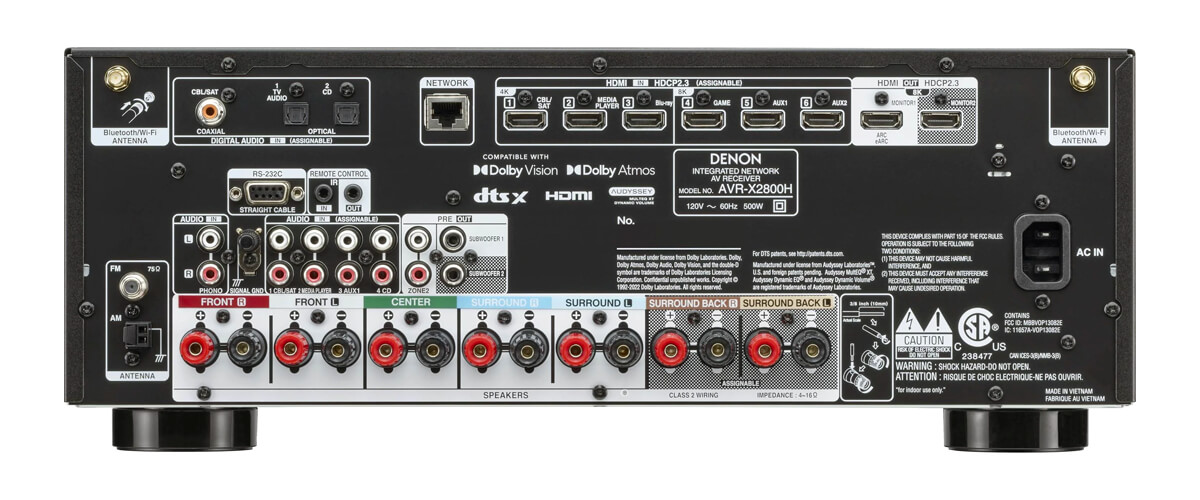
The model we’re reviewing has 6/2 HDMI 2.1 connectors with HDCP2.3 and eARC features, and HDR10, HDR10+, Dolby Vision, and HLG formats because it was released in 2022. For the 3 ports, 8K/60Hz video and upsampling to that resolution are available. And I will say that everything works great, and the picture is gorgeous, although 7 channel receivers often have a failing in this area. You also get optical, coax, phono input, bi-amping, and Multroom (audio) for 2 zones.
Wi-Fi and Bluetooth are the usual, but the AVR-X2800H has extensive capabilities in streaming services (compatible with more platforms) and voice assistants and has a built-in wireless multi-room HEOS system. All of these chips scored high in testing. It occurred to me, in general, that Denon has created a receiver that can compete with more expensive models (although, honestly, it’s not cheap itself, say, the upper limit of the budget segment).
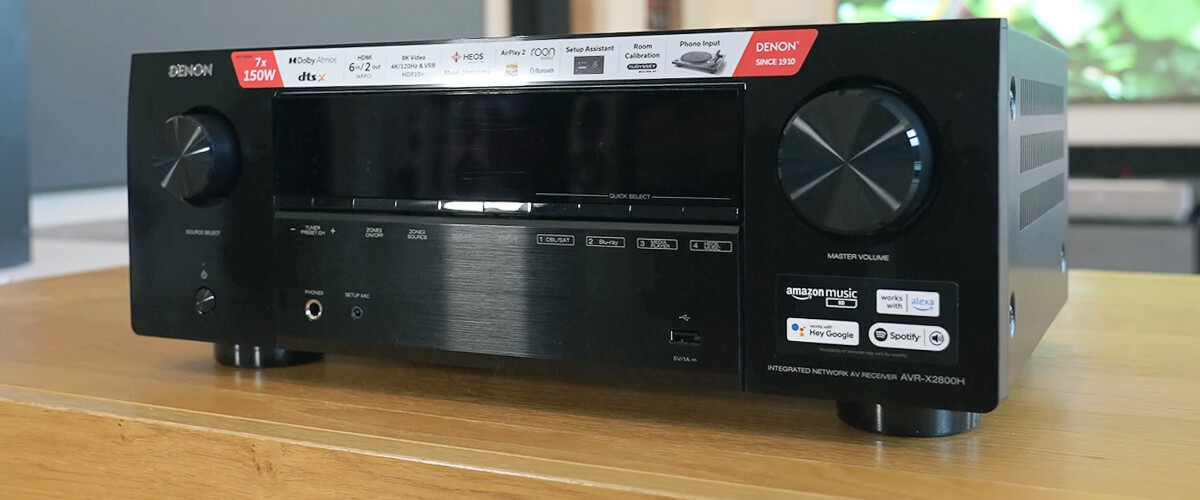
The receiver sounds great as well. It’s much better than many receivers of its rank. In music or surround sound (in addition to Atmos supports DTS:X), it gives out dynamics, brightness, accuracy, synchronization, and balance. Its warm sound suits many genres and is very good on vinyl. The AVR-X2800H can also simultaneously listen to content through speakers and headphones, which is handy if you have a deaf or hard-of-hearing person in your family. And support for DTS Virtual:X and Dolby Atmos Height Virtualization doesn’t require you to build additional speakers into the ceiling.
Denon AVR-X2800H is the best 7.1 receiver, which gets first place in my rating by combining sound quality, functionality, and price. Easy to install and use, it will brighten your evenings watching movies, listening to music, or playing games with the same level of experience.
Key specs
- Channels: 7.2.
- Power output: 95W/8 Ohm, 125W/6 Ohm.
- HDMI inputs/outputs: 6/2.
- Video functions: 8K/60Hz, 4K/120Hz, 4K/60Hz pass-through, 1080p to 8K/4K video upscaling via HDM.
- Bluetooth/Wi-Fi: yes/yes.
- Streaming services: AirPlay2, Deezer, Tidal, Pandora, Spotify, Amazon Music HD, TuneIn.
- Supports: HDMI ARC, HDMI eARC, HDMI CEC, HDCP2.3, HDR10, HDR10+, Dolby Vision.
- Surround sound: DTS HD Master, DTS Neural:X, Dolby TrueHD, Dolby Surround, Dolby Digital Plus, Dolby Atmos Height Virtualization, Dolby Atmos.
Pros
- An optimal value for money from the entire list.
- Easy and quick installation and setup.
- HDMI 2.1 works perfectly, transmitting a high-quality 8K picture.
- In testing, the receiver showed high results in wireless connection.
- Audio can be listened to simultaneously from speakers and headphones.
- Support for immersive formats DTS Virtual:X and Dolby Atmos Height Virtualization frees you from using special equipment.
Cons
- Audyssey’s calibration system treats the 2 subs as a single unit and does not allow individual adjustments.
Marantz Cinema 70S – also great
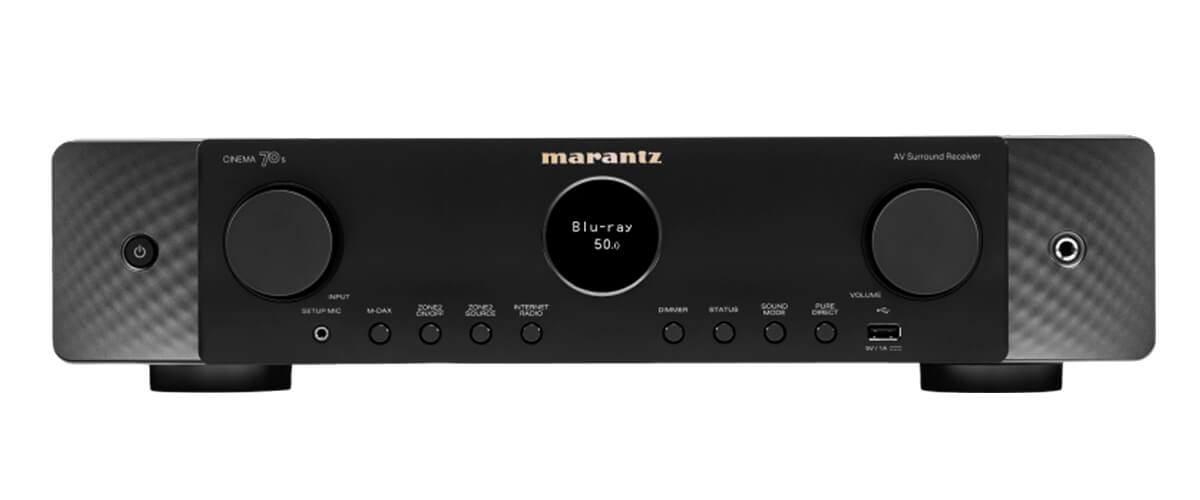
The second place on the chart is also very good, but less powerful (50 watts (8 Ohm, 20Hz – 20kHz, 0.08%, 2ch) 7.2 AVR called Marantz Cinema 70S. This low wattage is due to the receiver’s slim profile design, which is great if you want to assemble a compact system.
In the video, surround sound and wireless connectivity, the Marantz Cinema 70S and Denon AVR-X2800H receivers are so similar that I won’t repeat the description. I will only say that the receiver performs well, not inferior to full-size competitors. But what to say, the brand is known for its quality, and despite the more expensive models, in the presence of identical cheap ones, many people prefer Marantz products for this very quality.
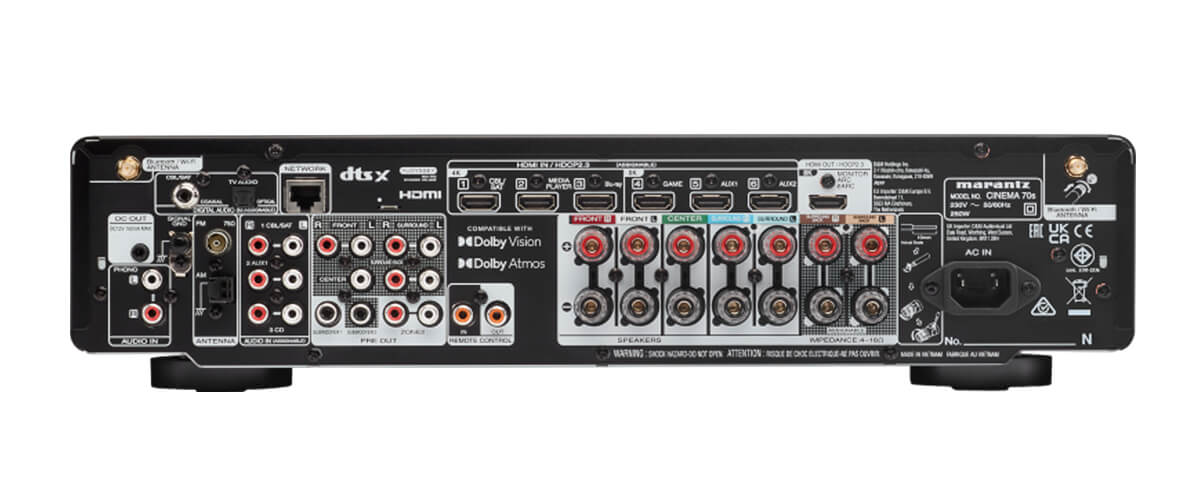
You may have a reasonable question: why does Cinema 70S cost as much as AVR-X2800H? Especially if we take into account the difference in power performance. The answer is simple: Marantz uses more expensive components and parts in the design, paying attention even to the connectors (which affect signal transmission quality). This device has incredible durability.
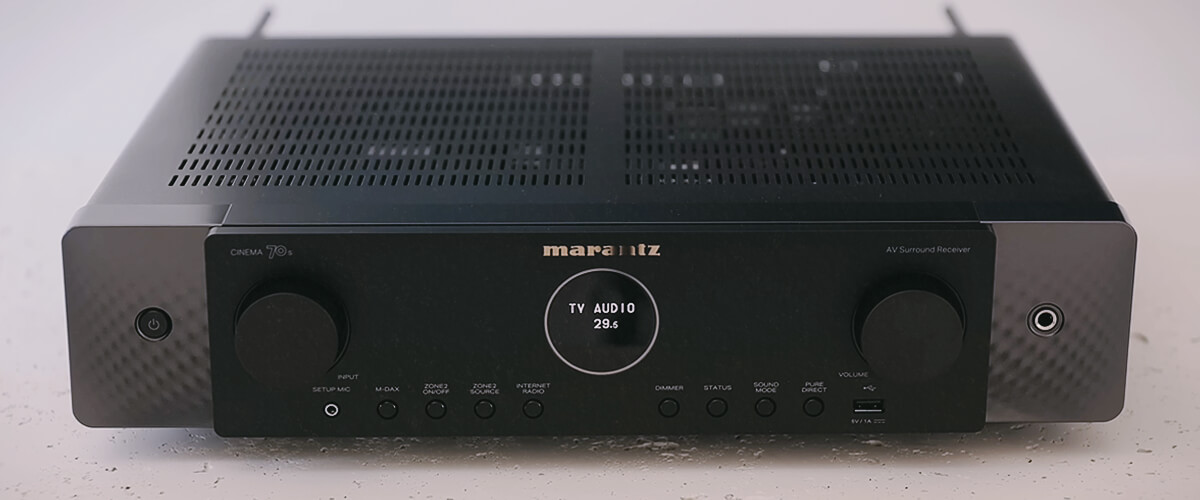
The receiver sounds smooth, balanced, and with the brand’s inherent warmth, which vinyl lovers greatly appreciate. It might not work as well for a room of about 400 square feet as the AVR-X2800H, but in a 250 square foot Cinema 70S room, I heard every detail of content viewed from BluRays with a Dolby Atmos soundtrack (as often with me, it was Marvel movies). The sound is superb, as it is for such a baby. When I watched Netflix content, the sound didn’t impress me as much. It was good, but not as varied. However, I don’t think it’s a receiver issue.
If space is limited, the Marantz Cinema 70S is a great alternative to a full-size 7-channel AVR. With it, you get functionality that will keep you from upgrading your system for a long time. And its sound, though not the most powerful, will give you evenings filled with warmth and quality when every detail will be heard as the author intended.
Key specs
- Channels: 7.2.
- Power output: 50W/8 Ohm, 70W/6 Ohm.
- HDMI inputs/outputs: 6/3.
- Video functions: 8K/60Hz, 4K/120Hz, 4K/60Hz pass-through, 1080p to 8K/4K video upscaling via HDM.
- Bluetooth/Wi-Fi: yes/yes.
- Streaming services: AirPlay2, Deezer, Tidal, Pandora, Spotify, Amazon Music HD, TuneIn.
- Supports: HDMI ARC, HDMI eARC, HDMI CEC, HDCP2.3, HDR10, HDR10+, Dolby Vision.
- Surround sound: DTS HD Master, DTS Neural:X, Dolby TrueHD, Dolby Surround, Dolby Digital Plus, Dolby Atmos Height Virtualization, Dolby Atmos.
Pros
- Narrow design for building a compact system.
- Excellent sound (for its segment) in surround sound and stereo.
- Used expensive components in the design.
Cons
- Lowest power in the rating.
Onkyo TX-NR6100 – budget
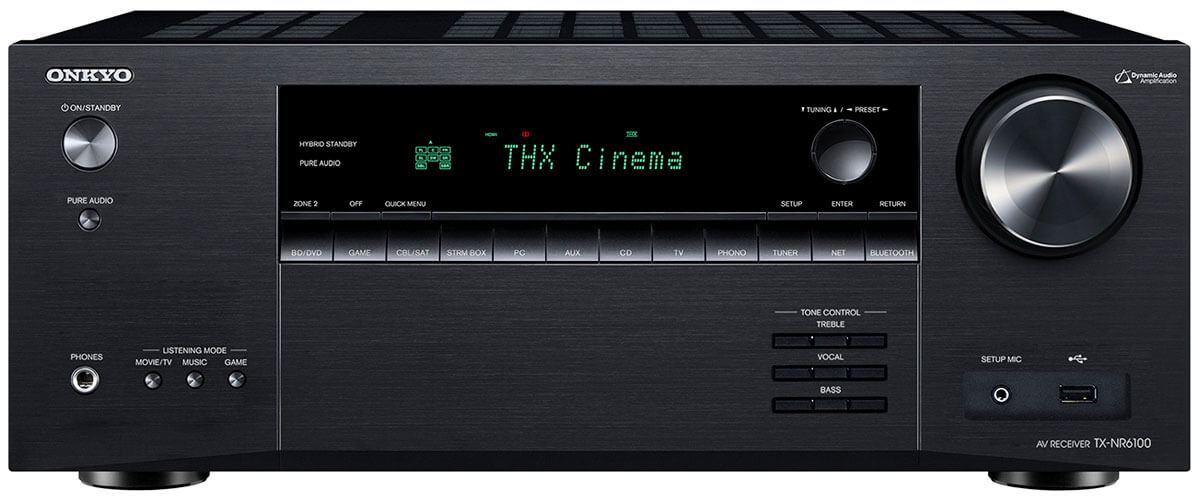
The cheapest variant of the considered category always occupies the third place in my picks. And the title of best budget 7.2 receiver goes to Onkyo TX-NR6100 because its optionality and quality exceed other models in the category up to $1000.
The receiver’s power is 100 watts per channel (8 Ohm, 20 Hz – 20 kHz, 0.08% THD, 2 ch). That means it’s nominally more powerful than the Denon AVR-X2800H. But in reality, TX-NR6100 doesn’t sound more powerful, and what’s worse – it has less detail and a smoother sound picture. For its price, it is more than good sounding. But since I’m comparing models here, I’m telling you what I hear. With the THX CERTIFIED option, you can make the sound brighter for some sources.
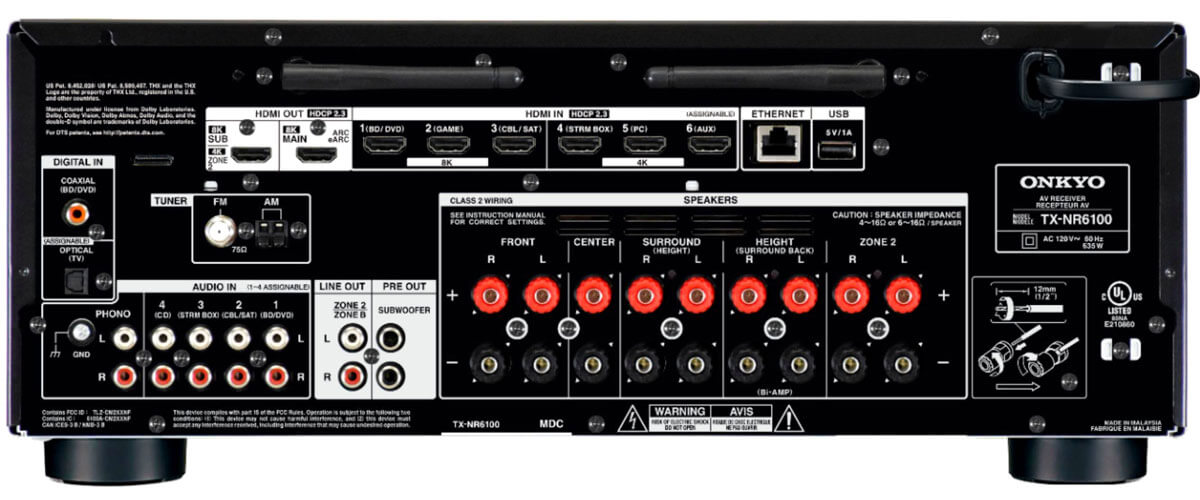
Video capabilities are identical to those described in the Denon AVR-X2800H review. But the video is scaled only up to 4K. But, unlike the first one, you can broadcast video from two sources to 2 zones. True, 8K quality is available for the first one, and for the second one, only 4K. And when you already thought, “Why pay more?” I’ll tell you that the Onkyo TX-NR7100 is incompatible with all TVs. And here, you need to be very careful to correctly select all the components of your future home theater system. Otherwise, in pursuit of the economy, you can get a lot of problems.

The model uses DTS Play-Fi and two-way Bluetooth (with support for SBC, AAC, and aptX), Chromecast built-in, and AirPlay 2 as wireless streaming. It has streaming services built in. But for Alexa’s voice control, you’ll need to buy a dedicated device. Saving money means paying extra. However… who needs this Alexa when it comes to a good, inexpensive receiver? But it’s up to you, of course.
SMART AV Receiver, as the manufacturer affectionately calls it, is a great option for an economical home theater. You can view high-resolution content with Dolby Atmos and DTS: X soundtracks, listen to music with a high-quality signal, broadcast video to 2 zones, and use game consoles, including the most modern ones. The disadvantages of Onkyo TX-NR6100 are quite acceptable and not critical for its category.
Key specs
- Channels: 7.2.
- Power output: 100W/8 Ohm, 210W/6 Ohm.
- HDMI inputs/outputs: 6/2.
- Video functions: 8K/60Hz, 4K/120Hz, 4K/60Hz pass-through, 1080p to 8K/4K video upscaling via HDM.
- Bluetooth/Wi-Fi: yes/yes.
- Streaming services: AirPlay2, Deezer, Tidal, Pandora, Spotify, Amazon Music HD, TuneIn.
- Supports: HDMI ARC, HDMI eARC, HDMI CEC, HDCP2.3, HDR10, HDR10+, Dolby Vision.
- Surround sound: DTS HD Master, DTS Neural:X, Dolby TrueHD, Dolby Surround, Dolby Digital Plus, Dolby Atmos Height Virtualization, Dolby Atmos, IMAX Enhanced.
Pros
- THX CERTIFIED technology makes the sound lineup clearer and brighter than the source sound.
- High-quality DTS Play-Fi and two-way Bluetooth with support for SBC, AAC, and aptX provide wireless connection.
Cons
- Although the receiver is more powerful at face value, its overall sound picture is smudgier than the more expensive models in the selection.
- It is not compatible with all brands of TVs.
- To use Alexa, you need to buy an additional device.
Yamaha RX-A2A
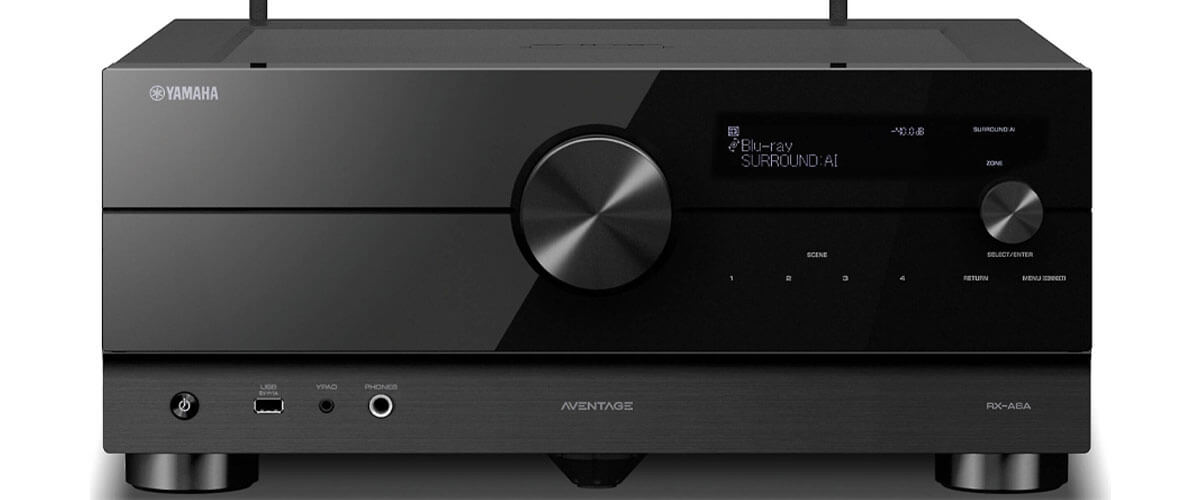
Another alternative to the Marantz Cinema 70S and Denon AVR-X2800H, and a great representative of the category in question, is the 2020 Yamaha RX-A2A. The initial model of the Aventage lineup, at an identical price to the first and second-place receivers. It is distinguished by a specific neutral, cold sound that may not appeal to everyone. Nevertheless, the brand has millions of fans, so you should find out if you might be one of them.
The receiver delivers 100 watts (8 Ohm, 20Hz – 20kHz, 2ch) of power with the lowest THD of 0.06% of the entire selection. It easily fills a high-ceilinged room with sound. In addition, the RX-A2A never overheated during operation. But in Dolby Atmos, Dolby Atmos Height Virtualization, and DTS:X surround sound formats, I still lack live warmth; everything is too crystalline, almost unreal. But adding to the effect with CINEMA DSP 3D technology, watching sports programs or action scenes is something. I can’t help but give it credit. However, for 7 channels, the technology isn’t as impressive as systems with more channels. Plus, the setup has options like YPAO, Pure Direct, and Adaptive DRC, and you have a pretty wide field to customize the system to your liking.
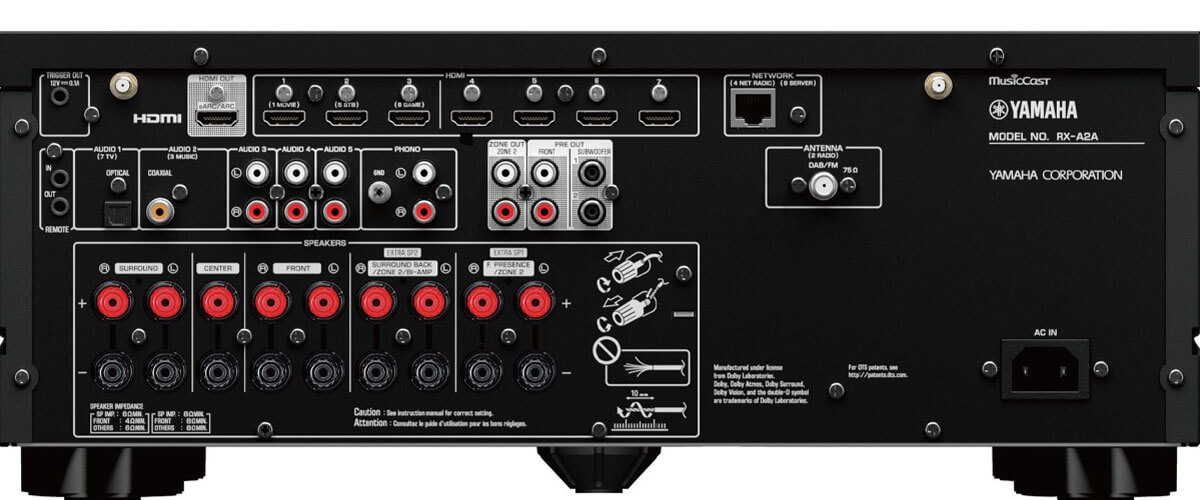
The RX-A2A has 7/1 HDMI connectors version 2.1. That’s more than its predecessors. In this area – it is an unambiguous winner.
But it’s fair to say that the OSD is incredibly slow. It’s not the biggest drawback for a receiver, especially for the price category. But oh my god, it just pissed me off.
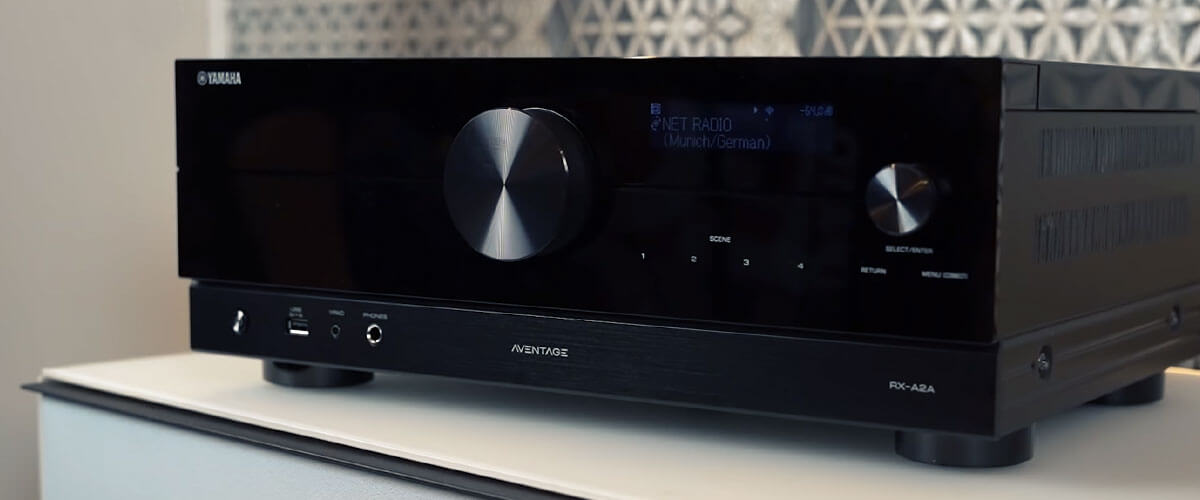
The wireless options are on par. Everything is there: Wi-Fi, Bluetooth, AirPlay 2 and multi-room MusicCast, support for streaming services, and voice assistants in different variants for iOS or Android lovers. Since all this is in the standard configuration, it works well, but not outstandingly. Sometimes, there are delays and jumps. But it is practically unnoticeable. Here, I should mention the Compressed Music Enhancer option, which improves the quality of the compressed audio to the original level. I really like playing with such things, it’s very cool.
Yamaha RX-A2A is a great home theater receiver in the category under consideration that I couldn’t pass up. It’s a modern device with great features, high sound quality, and quality construction details. The receiver is capable of a long service life. However, I recommend familiarizing yourself with Yamaha’s specific tones before purchasing.
Key specs
- Channels: 7.2.
- Power output: 80W/8 Ohm.
- HDMI inputs/outputs: 7/1.
- Video functions: 8K/60Hz, 4K/120Hz, upscaling up to 4K.
- Bluetooth/Wi-Fi: yes/yes.
- Streaming services: AirPlay 2, Spotify, TuneIn, Deezer, Tidal, Netflix, Amazon Prime.
- Supports: HDMI ARC, HDMI eARC, HDMI CEC, HDCP2.3, HDR10+, Dolby Vision.
- Surround sound: DTS:X, DTS Virtual:X, Dolby Atmos, DTS HD Master, Dolby TrueHD.
Pros
- The most powerful with the lowest THD of 0.06%.
- Never once overheated during testing.
- The highest number of HDMI version 2.1 ports of any of the competitors in my review.
- The compressed Music Enhancer option boosts compressed audio quality to its original level.
Cons
- Supports fewer surround sound formats than the Marantz Cinema 70S and Denon AVR-X2800H.
- Slow on-screen menus.
Pioneer Elite VSX-LX105
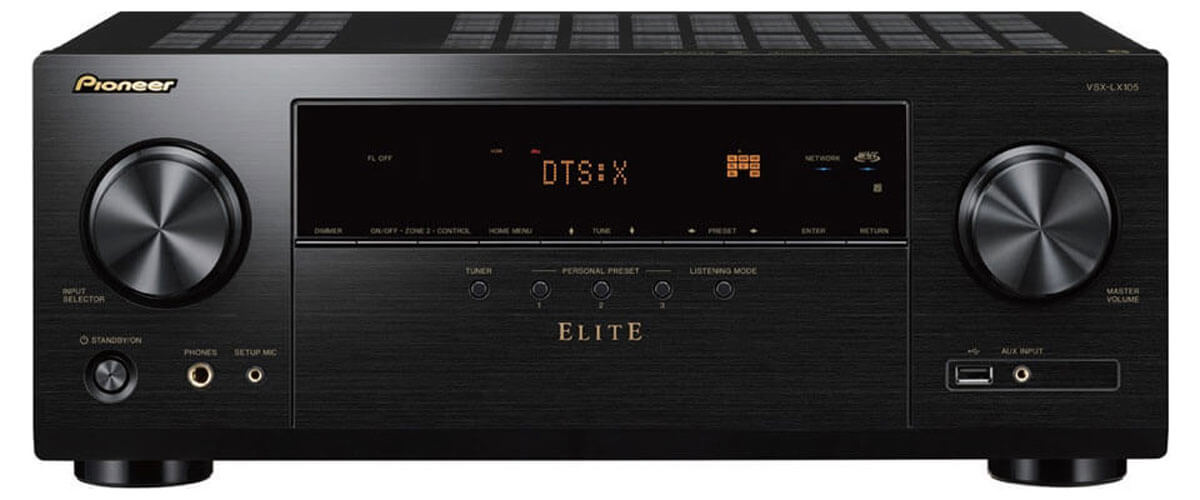
Well, and lastly – an alternative to the described budget Onkyo TX-NR6100. And this is surround sound receiver Pioneer VSX-LX105 with 100 W/ch power (8 Ohm, 20 Hz-20 kHz, THD 0.08 %, 2ch). Brands, in general, go hand in hand, offering us, buyers, a wide range of inexpensive but functional devices.
Model 2021 has all the qualities described for other receivers in this rating. It works with surround sound encoded in Dolby Atmos, DTS:X, and their virtual versions. The 3 HDMI ports are version 2.1 (8K video and other features have already been described in the review). Pioneer VSX-LX105 implements Bluetooth with support for SBC and aptX HD codecs, DTS Play-Fi, and AirPlay 2 (like Onkyo TX-NR6100). Also, from the pluses, we can note the ability of AVR to broadcast movies with a monaural soundtrack with parallel elimination of distortion in the center channel.
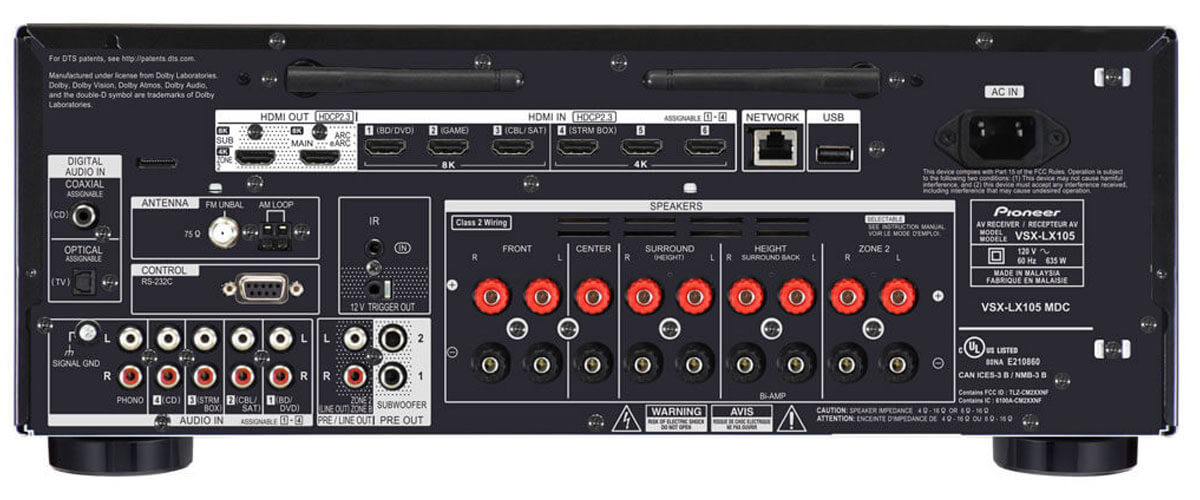
I didn’t like the design of this model. It is simple (although it is normal for receivers) but with a lot of plastic and no separate crossover adjustment for each speaker. These are, of course, not critical remarks, but I have to tell you about them.
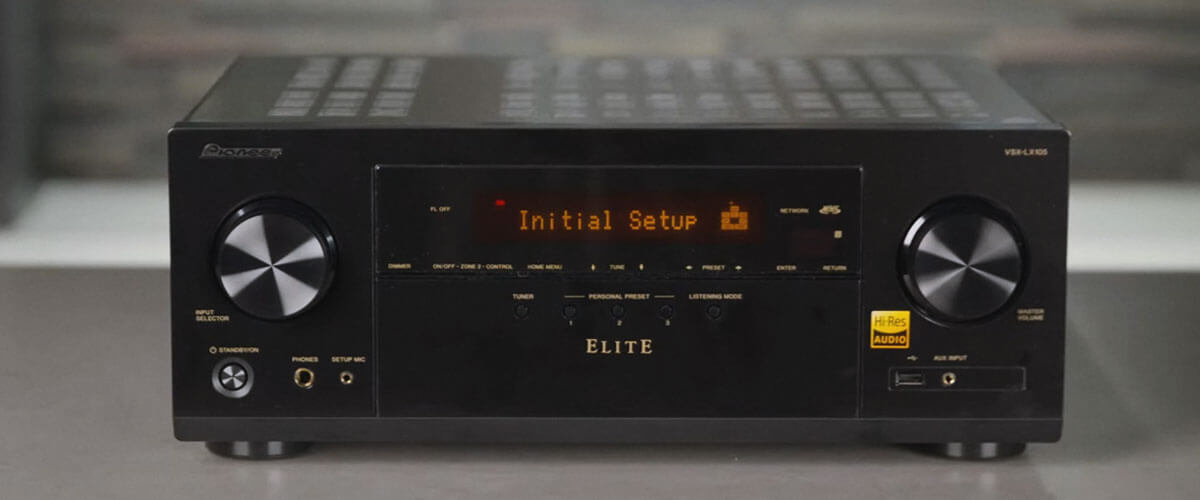
When you read the review or test the receiver yourself, always keep in mind its price category. The Pioneer VSX-LX105 is an inexpensive receiver even in its category (as is the Onkyo TX-NR6100). That’s why I have lower requirements than its more expensive brethren. The brand has been on the market for many years and knows exactly what it does, focusing mainly on the sound of its products. This receiver is good in surround sound, easy to operate, has enough features, and meets modern needs and standards. There are some minor drawbacks in stereo. For example, I liked the Bluetooth audio transmission less than Onkyo’s.
The Pioneer Elite VSX-LX105 is designed for users not obsessed with the brand name or sound settings as in world-class concert halls. It will satisfy the average user’s needs, give surround sound and video, and, with good handling, will last for many years. A worthy choice of rational people.
Key specs
- Channels: 9.2.
- Power output: 100W/8 Ohm, 210W/6 Ohm.
- HDMI inputs/outputs: 6/2.
- Video functions: 8K/60Hz, 4K/120Hz, upscaling up to 8K.
- Bluetooth/Wi-Fi: yes/yes.
- Streaming services: AirPlay 2, Spotify, TuneIn, Deezer, Tidal, Netflix, Amazon Prime.
- Supports: HDMI ARC, HDMI eARC, HDMI CEC, HDCP2.3, HDR10, HDR10+, Dolby Vision.
- Surround sound: DTS HD Master, DTS Neural:X, Dolby TrueHD, Dolby Surround, Dolby Digital Plus, Dolby Atmos Height Virtualization, Dolby Atmos.
Pros
- The receiver’s functionality is not inferior to other rating models.
- AVR can broadcast movies with a monophonic soundtrack with parallel elimination of distortions in the center channel.
Cons
- It’s not the most reliable receiver design.
- There is no individual adjustment for each speaker.
- The Bluetooth broadcast loses a little bit to Onkyo TX-NR6100.
What to look for when choosing a 7.1 receivers
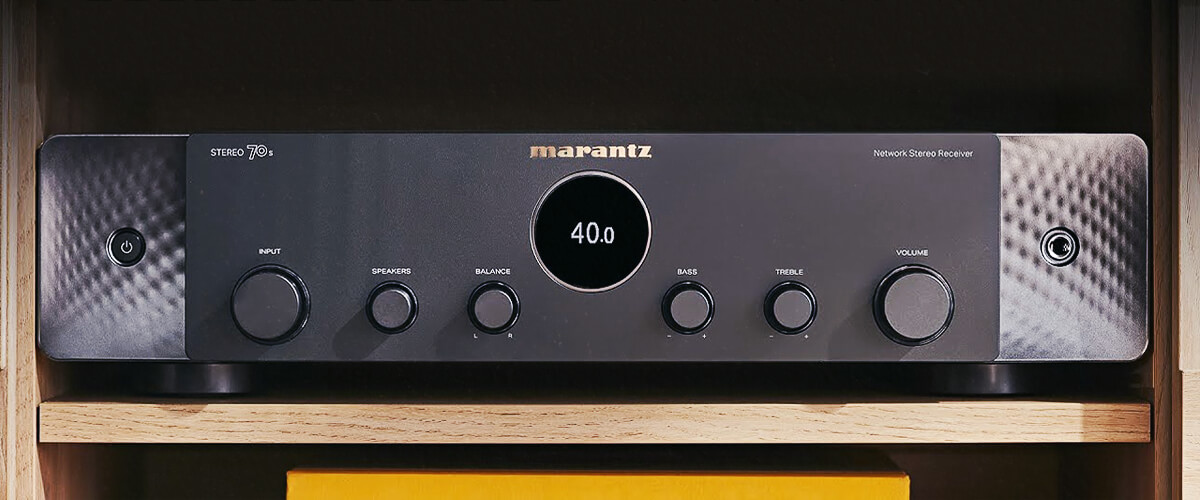
What receiver power do you need?
For 7-channel receivers, the average power rating ranges from 75-100W. This is enough to evenly fill a room of about 300-400 square feet so you can clearly hear what is happening on the screen in every corner.
However, this is not the most important parameter when selecting an AV receiver because budget players may have significant wheezing and interference at high (maximum) volume. This is because of the THD indicator of harmonic distortion. It is usually written next to the power in the product specification, and its value is the better, the lower the parameter. A distortion coefficient greater than 1% for this type of equipment, such as a receiver, is considered bad. So, a system with 80W/0.08% data may sound louder or identical to 100W/0.8% but cleaner at maximum.
What connections do you need
7-channel receivers are equipped with slightly more connections than 5-channel receivers. But still, it cannot be said that there are no limitations here. Therefore, the algorithm for analyzing connectors should be based on your equipment, the one you plan to buy, and the priority of devices in your system.
As usual, they’re HDMI ports version 2.1 because they have modern functionality (8K video, eARC, HDCP 2.3 and CEC, and gamer features), and you won’t need to upgrade your receiver for a long time. But the thing is, budget AVRs can have issues with some options working, so I recommend reading reviews and reviews for the model you’re considering buying.
Outputs for separate subwoofers phono input for a vinyl player can make the system’s sound richer, fuller, and more diverse, so you should also pay attention to their presence. You may also love the USB connector.
Optical, component, and coaxial inputs will be needed if you do not want to part with aging equipment. But in 7-channel receivers, you can most often find only their digital versions.
Built-in Wi-Fi, multiroom and streaming services
Also, 7-channel receivers have more wireless connectivity options than 5-channel receivers. Usually, such AVRs have built-in Wi-Fi and Bluetooth, and more and more often, in new models, you can meet their improved versions and additions such as DTS Play-Fi, AirPlay, or Chromecast or support for aptX, SBC, or AAC codecs for Bluetooth 4.2. This significantly affects the quality of lossless signal broadcasting in high quality and without sags and delays.
Many models support streaming services and voice assistants, sometimes even have built-in options, as well as wireless multi-room broadcast systems. Denon and Marantz almost always have HEOS, and Yamaha has MusicCast. Other models may have other systems like Sonos.
I recommend researching this area, especially the desired receiver’s compatibility with your home equipment (OS support). For example, some AVR models write “made for iPhone”.
4K, 8K, HDR support
Pay attention to the receiver’s support for 4K and 8K video resolutions and the ability to upscale to these quality levels. Dolby Vision, HDR, HDR10, and HDR10+ will also make the picture bright and clear. 7-channel receivers usually support some of these. Remember that you need a proper TV to use them, and if you are not planning to buy one, it may not be worth overpaying for such features. One more important point in this matter: today, there is still not enough content in 8K, but eventually, all platforms will move to it.
Surround sound formats
Of course, surround sound is the most important reason to buy an AV receiver. In addition to handling basic immersive formats, the device with 7 amplification channels offers Dolby Atmos and DTS:X decoding, the most popular today. With the addition of the upper channels, these technologies provide a more immersive experience and a true movie theater effect, where sound surrounds you from all sides.
However, the 7.2 configuration (or 5.2.2 for Dolby Atmos) cannot fully utilize the described surround sound formats, but only a lighter version of them. Therefore, I would pay attention to the support of their virtual varieties, Dolby Atmos Height Virtualizer and DTS Virtual:X. After all, they don’t oblige you to buy special speaker equipment and build it into the ceiling, and the soundscape they provide is closer to that of using physical ceiling speakers.
We are supported by our audience. When you purchase through links on our site, we may earn an affiliate commission at no extra cost to you.
Our newsletter
* We will never send you spam or share your email with third parties

![Best Budget Receivers [Reviewed and Tested]](https://thetechholics.com/wp-content/uploads/2023/10/best-budget-av-receiver-300x150.jpg)
![Best 9-Channels AV Receivers [Reviewed and Tested]](https://thetechholics.com/wp-content/uploads/2023/10/best-9-2-receiver-300x150.jpg)

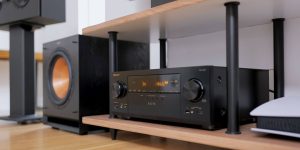
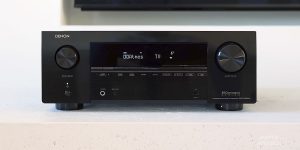
![Pioneer vs Denon Receivers [Top Models Compared and Tested]](https://thetechholics.com/wp-content/uploads/2023/10/denon-vs-pioneer-review-300x150.jpg)
